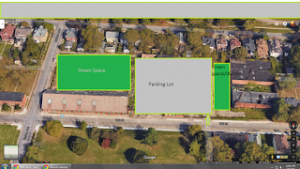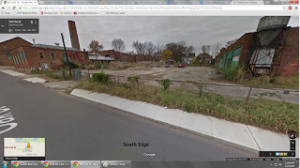This lot has the potential of becoming a successful small urban agriculture operation, the available space can sustain a few greenhouses and potentially a store to sell home-grown vegetables and fruits to the community.
In many inner-city, low-income communities, there exists a strong need for quality, affordable food other than the typically cheap fast food that when consumed frequently can lead to serious health problems and reduced life span. In fact, based on the surrounding residential structures and vacant lots, it makes sense to place an small agricultural operation, as it will meet an urgent demand for good food. We’re assuming that the zoning for this site is commercial, but if it isn’t, in order to legally match the intended purpose of the complex, a variance should be sought out by the developer.
An idea for individual buildings in the lot is as follows: the four rectangular buildings to the right of the complex could be refurbished into green houses. These green houses and or complexes could be operational year-round and grow fresh food and vegetables for the community in any season. Different buildings could grow different crops, being controlled with a state of the art heating/cooling system that would keep the temperature inside the buildings appropriate for the crops.
For the long horizontal building that is located on the west side of Kelton Avenue, this building could be re-purposed into a small-indoor retail center for the selling of home-grown vegetables and fruits from the greenhouses. Not only could it be the place where goods from the greenhouses would be sold, but it could also host farmers and companies that promote healthy food and lifestyle products. This space could also facilitate school programs from the neighborhood and those that visit the Franklin Park Conservatory as a place to learn about how fresh fruit is grown.
The lot space in the center could be used for parking, that would allow for motorists to keep their vehicle off the one-way and allow them to buy fresh produce. A driveway would be installed on Oak St since it is a two way, providing easier access for patrons. The area in front of the long building could be used as a green space for patrons to sit and relax. Any additional space next to the large building could be used for composting community food waste.
In order for this to be possible, significant capital will be required to refurbish and repurpose the smaller buildings into greenhouses. Updating and enclosing the buildings with new utilities and climate control systems will presumably be expensive. Community outreach will be critical for funding this project in addition to seeking out corporate, non-profit sponsorship. Another consideration is providing access to cars, and how this will be planned in consideration of the one-way northbound traffic on Kelton Avenue.
While there are significant challenges, an urban agriculture retailer would provide the community with local, affordable, quality food that many low-income communities lack. Finally, an agriculture operation could stimulate residential development in the area and increase economic opportunities to those already residing.




